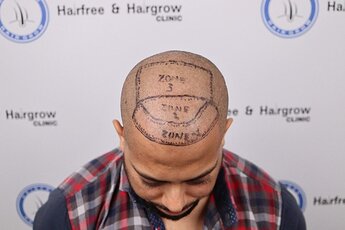Hair loss affects confidence in a way many people do not openly talk about. If you are thinking about a hair transplant, it is normal to have questions such as, “Is this treatment safe?” Will it look natural? Which technique should I choose?
To help you understand the journey better, here is a real transformation story of Mr. Suryank Parmar, a 37-year-old from Vadodara. This case study will give you a clear idea of the complete hair transplant process in a simple, friendly, and informative manner.
Patient Profile
-
Name: Mr. Suryank Parmar
-
Age: 37 years
-
Location: Vadodara, Gujarat
-
Baldness Condition: Grade 3 to 4
-
Hair Loss Duration: 4 to 5 years (visible for the last 2 to 3 years)
-
Family History: Baldness on maternal side (genetic)
-
Additional Concerns: Mild itching and occasional scalp pimples
-
Past Treatments: Minoxidil and multivitamins with mild improvement
Common Patient Question: “If hair loss runs in my family, will a transplant still work for me?”
Yes. As long as you have a healthy donor area, a hair transplant can give excellent results.
Initial Consultation and Assessment
When Mr. Suryank visited the clinic for the first time, he had completely lost his frontal hairline, and the mid-scalp area showed visible thinning. A trichoscopy test was done to study his scalp and donor area.
Findings:
• The donor area had healthy, thick hair suitable for transplantation.
• An allergy test for anesthesia was conducted, and results were normal.
Once the procedure, expected results, and post-care plan were explained, he confidently decided to go ahead with the I-FUE hair transplant.
Did You Know?
A detailed consultation helps the doctor plan a result that suits your face shape, age, and future hair loss pattern.
Why the I-FUE Technique Was Chosen
Many patients ask, “What is special about the I-FUE method?”
I-FUE (Intelligent Follicular Unit Extraction) is a refined method of hair transplantation that focuses on natural results, less discomfort, and faster healing. It involves extracting individual grafts without visible scarring and ensuring a natural-looking outcome.
Doctor’s Insight:
“We selected the I-FUE method for this case because the patient needed a natural hairline and good density, along with faster recovery. I-FUE is very effective for such requirements.”
Procedure Date: 2 August 2022
Step-by-Step Procedure
- Hairline Designing and Planning
A personalized and age-appropriate hairline was designed to suit his facial profile. The front and temple areas were marked for rebuilding, and the mid-scalp was planned for density improvement.
- Scalp Preparation and Anesthesia
The scalp was shaved and cleaned. Local anesthesia was given through a comfortable, pain-controlled technique.
- Slit Creation (Recipient Area)
Fine slits were created for graft placement.
• 1.2 mm blade for the front hairline to achieve a soft natural look
• 1.4 mm blade for the rest of the scalp for density
The direction and angle of each slit were designed to match natural hair growth.
- Graft Extraction
Grafts were extracted from the donor area using a 0.8 mm titanium punch under magnification. Most grafts were double or triple rooted, which helps achieve better density. A total of 3817 grafts were safely collected and stored in chilled Ringer’s lactate solution to preserve freshness.
- Graft Implantation
Using the K.E.E.P. implanter, the grafts were carefully implanted into the marked areas for maximum survival and natural placement. This procedure took around two hours. After implantation, dressing and post-care instructions were provided.
Recovery and Hair Growth Stages
- Months 1 to 2: Shedding Phase
Around 70 percent of the transplanted hair shed during this period, which is completely normal. Two PRP sessions were given to improve healing. The donor area recovered within 30 days.
- Months 3 to 4: Baby Hair Growth
New baby hairs started appearing by the fourth month. A third PRP session was given to support the growth of both new and existing hair.
Motivation for Patients:
Visible results take time. Slow and steady growth is normal and part of the natural process.
- Months 6 to 9: Active Growth
By the seventh month, nearly 80 percent of visible growth was achieved. A booster PRP session was done in the ninth month to enhance the final outcome.
- Months 10 to 12: Final Results
By the tenth month, the patient achieved natural-looking density and was able to style his hair freely. He continued with minoxidil and a DHT blocker for maintenance.
Final Results and Experience
• Full and natural-looking hairline restored
• Mid-scalp density successfully improved
• No visible scars or complications
• Donor area healed well
• Patient regained confidence and satisfaction
Key Learning for Patients
• Proper planning creates natural-looking results.
• Strong donor grafts help achieve lasting density
• Doctor’s technique and precision influence natural growth patterns
• Post-care, PRP support, and patience improve results.
Doctor’s Insight:
“A hair transplant is not only about placing hair. It is about designing a look that suits your personality and long-term appearance.”
Conclusion
This case clearly shows how modern I-FUE techniques, combined with PRP and guided medical care, can provide natural and long-lasting results. With the right diagnosis, expert planning, and proper follow-up care, hair restoration can bring back not just your hair but also your confidence.
If you are struggling with baldness or hair thinning, consulting a hair transplant specialist can help you understand the best treatment for your condition.



